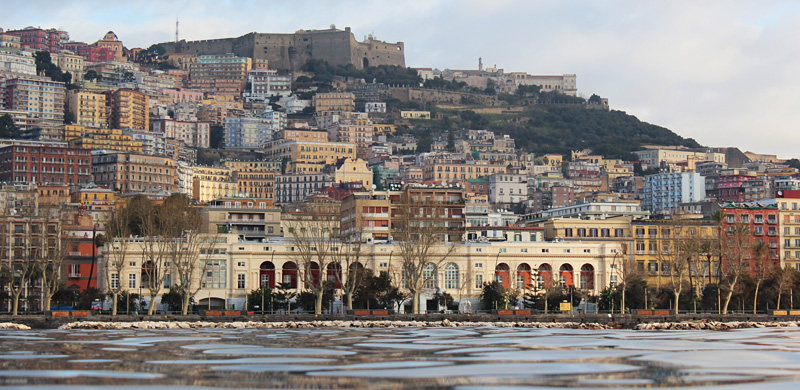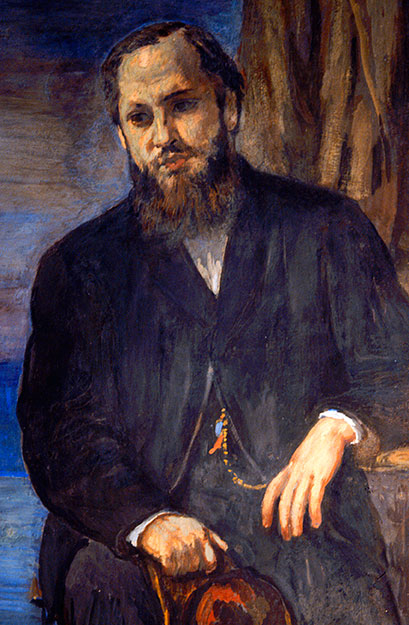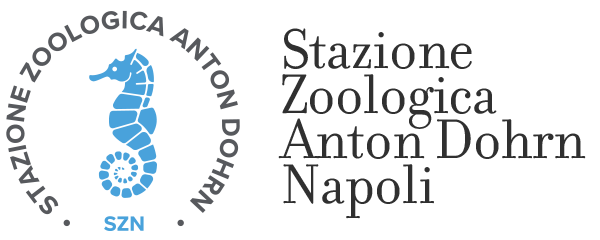No profit organizations, cultural associations and charities support Stazione Zoologica and participate in the accomplishment of its objectives. In particular, these associations protect, promote, and enhance the artistic and historical heritage, scientific research, education, and dissemination activities related to Stazione Zoologica.
In addition, these activities promote the connection with students and researchers who worked in the past at Stazione Zoologica (Ex Alumni) and stimulate the participation to scientific associations in the fields of interests of Stazione Zoologica.
Inaugurazione anno della ricerca 2019
Scoperto il gene del sesso delle Diatomee
Thiolava veneris nella top ten delle nuove specie scoperte
Press Release - Un Nuovo Cluster Tecnologico a Napoli
Press Release -Differenze Genomiche
How a 700-million-year-old DNA glitch could explain why humans have limbs
Press Release - WORKSHOP INNOVATION FOR A SUSTAINABLE OCEAN ECONOMY
Press Release - #GenerAzioneMare
Press Release - Ocean Acidification Day
Press Release - I Capelli di Venere
Press Release - Campagna Jairo-Mediterraneo
Press Release - SKELETONEMA MARINOI
Press release - I vetrini di Boveri tornano a Napoli
Press release - Studio sulla Posidonia Oceanica
Press release - An ecosystem-based deep-ocean strategy (13 febbraio 2017)
Abissi come l'Antartide "Devono essere tutelati" - La PREALPINA
Il Mare Profonod per Unire i Popoli - l'Unità
Press Release Marine Turtles Research Centre Opening - Portici (January 20, 2017)
Scienziati di chiara fama e nuovi progetti, i “vents” di Ischia sono un riferimento mondiale - QuiIschia
Pristine Seas, così National Geographic convince gli Stati a salvare gli ultimi paradisi negli oceani - QuiIschia
Sorpresa nel Golfo di Napoli, trovata un'ostrica gigante - La Repubblica Napoli
Ostrica gigante e centenaria nel Golfo di Napoli - Corriere del Mezzogiorno
Nel golfo di Napoi un'ostrica gigante - ANSA Campania
Le Tartarughe tornano libere - Metro
Tartarughe a Ostia - Salvate dalle reti tornano a casa - Il Messaggero Cronaca di Roma
Ritornano nel "loro" mare le tartarughe Caretta - Il Tempo 9 giugno 2016
Torneranno in mare due tartarughe ferite - Il Tempo 8 giugno 2016
Festa a Battipaglia: le tartarughe Omero, Babason, Alessandra e Gonzala tornano in mare - La Repubblica Napoli
Su "Scientific Reports" l'alga invisibile che minaccia i ricci della Gaiola - La Repubblica Napoli
La ricchezza dimenticata delle acque profonde - Origami de La Stampa
Eni Award Lectures, lezione sul futuro dei mari siciliani - See more
Il Ritorno di Agata Christie, la tartaruga marina che ama la Campania - La Repubblica
Due Tartarughe Caretta caretta tornano in mare: munite di GPS - Il Mattino
Biologi marini al capezzale del Mediterraneo invaso da "specie aliene" che arrivano dal canale di Suez - Il Mattino
Prosegue l'Euromarine Workshop, protagoniste anche le specie aliene delle Isole Flegree - Qui Ischia
Specie aliene nei nostri mari, da Ischia il campanello d'allarme - La Repubblica
Mille metri sotto il mare, un robot a caccia di rifiuti nel Golfo di Napoli - Corriere del Mezzogiorno
SCIENZA, SU ‘NATURE’ STUDIO DELLO STAZIONE ZOOLOGICA DOHRN -OmniNapoli
Read More
Su Nature lo studio della Stazione Zoologica Anton Dohrn -Il Mattino
Read More
"Antenne in mare per controllare il Golfo" - Corriere del Mezzogiorno
Read More
"Dohrn, la Pompei del mare" - Corriere del Mezzogiorno
Read More
Il ministro Giannini "Stazione Dohrn, è come la Pompei degli acquari." - Mattino
Read More
Giannini alla Dohrn. "Questa è la Pompei degli acquari" - Repubblica
Read More
Arriva il Ministro, tensione con gli studenti - ROMA
Read More
Cnr: virus e fitoplancton contrastano il riscaldamento globale - R.it - Ambiente
Read More
Campania - Osservatorio del Mare, 11 partner istituzionali impegnati nel monitoraggio, protezione e valorizzazione del territorio - StabiaChannel.it
Read More
Nasce l'Osservatorio del Mare e del Litorale Costiero: "Un modello di cooperazione" - NAPOLITODAY.IT
Read More
Osservatorio del Mare e del Litorale Costiero istituito in Campania - L'INFORMATORE NAVALE
Read More
Presentato l'Osservatorio del Mare - Julienews.it
Read More
Osservatorio del Mare e del Litorale Costiero istituito in Campania - ilMetropolitano.it
Read More
Nasce l'Osservatorio del mare e del litorale costiero - ILMATTINO.it
Read More
Istituzioni e centri ricerca insieme per Osservatorio Mare - ANSA.IT
Read More
Un Centro ricerche e un Turtle point nell'ex Macello - la Repubblica.it
Read More
Napoli - Il Museo del Mare nella Casina del Boschetto
Watch the Video
Nella Casina del Boschetto nascerà il Museo del Mare - video.corrieredelmezzogiorno.corriere.it
Watch the Video
Comune, la Casina del Boschetto andrà alla stazione zoologica Anton Dohrn - corrieredelmezzogiorno.corriere.it
Read More
La Casina del Boschetto della Villa Comunale in gestione alla Stazione Zoologica Anton Dohrn - www.vivere.napoli.it
Read More
Nella Casina del Boschetto nascerà il Museo del Mare - www.vivere.napoli.it
Read More
Casina nel Boschetto, da Ex circolo della Stampa a Museo del Mare, intesa tra Comune e Stazione Dohrn - www.napolipost.com
Read More
La Casina del Boschetto - www.napoli.com
Read More
Napoli. La casina del boschetto tornerà a vivere col Museo del Mare - www.ilmattino.it
Read More
Un noto edificio storico di Napoli diventerà Museo del Mare - www.vesuviolive.it
Read More
La ciclo-staffetta Mesothalassia arriva alla Stazione Zoologica - www.comunicareilsociale.com
Read More
La ciclo-staffetta Mesothalassia alla Stazione Anton Dohrn - corrieredelmezzogiorno.corriere.it
Read More
Mesothalassia, la ciclo-staffetta ecologica fa tappa a Napoli - www.campaniasuweb.it
Read More
La ciclo-staffetta ecologica Mesothalassia arriva MARTEDì 7 luglio alla Stazione Zoologica - www.lastampadelmezzogiorno.it
Read More
L’ex Circolo della Stampa diventerà Museo del Mare, si recupera la Casina del Boschetto - www.corrieredelmezzogiorno.corriere.it
Read More
Focus sulla ricerca ecologica della stazione zoologica - Il Denaro
Read More
The foundation
 The foundations of the Zoological Station were laid in March 1872. Anton Dohrn, founder and first director, was born in Stettin, in Pomerania, now part of Poland, in 1840, into a well-to-do bourgeois family. Dohrn studied zoology and medicine at various German universities, but without much enthusiasm. His ideals changed in summer 1862 when he arrived at Jena where Ernst Haeckel introduced him to the works and theories of Charles Darwin. Dohrn became a fervent defender of Darwin's theory of 'descent with modification', the theory of evolution by natural selection. He decided to devote his life to collecting facts and ideas in support of Darwinism, the starting point of a lifelong adventure.
The foundations of the Zoological Station were laid in March 1872. Anton Dohrn, founder and first director, was born in Stettin, in Pomerania, now part of Poland, in 1840, into a well-to-do bourgeois family. Dohrn studied zoology and medicine at various German universities, but without much enthusiasm. His ideals changed in summer 1862 when he arrived at Jena where Ernst Haeckel introduced him to the works and theories of Charles Darwin. Dohrn became a fervent defender of Darwin's theory of 'descent with modification', the theory of evolution by natural selection. He decided to devote his life to collecting facts and ideas in support of Darwinism, the starting point of a lifelong adventure.
During his academic career, Dohrn worked several times at facilities located on the seashore: Helgoland, Hamburg, Millport in Scotland and Messina. Here took shape the project to cover the globe with a network of stations of biological research, similar to train stations, where scientists could stop, collect material, realize observations and experiments, before moving to the next station. The possibility to use marine organisms for studies of systematic, physiology and morphology, as well as their possible economic interest, had led many biologists and academic institutions to try to establish research facilities on the shores of the sea. The first marine laboratory was founded in 1843 in Oostende. In France, the first workshop on the shores of the Sea was founded during the 50s in Concarneau, on the southern coast of Brittany. A French laboratory was founded in Wimereux, Roscoff in 1873, and another laboratory was founded in 1881 in Banyuls-sur-Mer on the Mediterranean coast. In the United States the stages were substantially similar, indicating the existence of a widespread need for this type of institutions. Louis Agassiz in 1873 founded the Anderson School of Natural History, a Pekinese Island, Johns Hopkins University in 1878 he founded the Chesapeake Zoological Laboratory, was founded in 1888 at the Woods Hole Marine Biological Laboratory and in 1892 on the west coast, the Hopkins Marine Station California. All these institutions were still marine structures linked to research institutions or universities, and not independent structures that could host a variety of different researchers and projects. In addition, the American and French marine institutions were mainly for educational purposes, although during the Summer research was carried out, while the Zoological Station in Naples, as the laboratories in Trieste and Sevastopol, were used exclusively for research and advanced teaching
 Facing many difficulties, Dohrn started to fantasize about the possibility for marine biologists to reach the sea and to find a work table ready, with a laboratory, services, chemicals, magazines and books, and information on where and when certain species could be found, together with information on the local conditions of the sea, the sea bed, the coast. Dohrn, after trying to carry out his project in Messina, decided that Naples would be the ideal place for his station. The choice of this city was due to the great biological richness of the Mediterranean Sea and to the opportunity to develop a research of great international importance in a city internationally oriented and large. After visiting the aquarium in Berlin, which had just been opened, he had thought that a public aquarium could earn enough to pay for a permanent assistant for the laboratories. Naples, with its 500,000 inhabitants was one of Europe's largest and most attractive city, with a large influx of tourists (30,000 per year), potential visitors of the aquarium.
Facing many difficulties, Dohrn started to fantasize about the possibility for marine biologists to reach the sea and to find a work table ready, with a laboratory, services, chemicals, magazines and books, and information on where and when certain species could be found, together with information on the local conditions of the sea, the sea bed, the coast. Dohrn, after trying to carry out his project in Messina, decided that Naples would be the ideal place for his station. The choice of this city was due to the great biological richness of the Mediterranean Sea and to the opportunity to develop a research of great international importance in a city internationally oriented and large. After visiting the aquarium in Berlin, which had just been opened, he had thought that a public aquarium could earn enough to pay for a permanent assistant for the laboratories. Naples, with its 500,000 inhabitants was one of Europe's largest and most attractive city, with a large influx of tourists (30,000 per year), potential visitors of the aquarium.
Putting together imagination, willpower, diplomatic skills and a good dose of luck, thanks to the friendly support of scientists, artists and musicians, Anton Dohrn overcame doubt, ignorance and misunderstanding and was able to persuade the local authorities to give him, free of charge, a piece of land on the shore of the sea in the beautiful Villa Comunale, called Royal Park. He promised to build the Zoological Station at his own expenses. Dohrn knew exactly what he wanted and how, and he prepared the construction projects. The foundations were laid in March 1872 and in September 1873 the building was finished. After the first building, currently the central part, a second building, connected to the first by a bridge, was added in 1885-1888, while the courtyard and the western part were built in 1905. Only fifty years later, the library was inserted between the first and the second building.
The public aquarium, which covers an area of 527 square meters, was opened on Jan. 26, 1874 and it remains unique because it has changed very little since its creation, and it is the oldest aquarium in the nineteenth century still working, exclusively dedicated to the fauna and flora of the Mediterranean. It was built under the supervision of William Alford Lloyd, a British engineer who had contributed to the project of public aquariums in Hamburg and London.
The official opening of the Zoological Station took place in April 14, 1875 and in December of that year contract was signed between Anton Dohrn and the City of Naples, represented by the Mayor, Senator Antonio Winspeare.
One feature important for the success of the institution was the remarkable agility and flexibility of its structure. It was an international institution by nature, founded by a German, managed as a family business and organized according to the German academic model, but localized in Italy, with an opening at the scientific and financial contributions of each country and institution. The idea of an agile, flexible, small but full of courage and spirit of initiative, characterizes the 'spirit' of the Stazione Zoologica Anton Dohrn, from its origins to today.
In order to promote the international nature of the station and to ensure its economic independence, and thus political, and the freedom of research, Dohrn introduced a series of innovative measures to finance his project, like renting work and research spaces ("research tables") for an annual fee the partners (universities, governments, scientific institutions, private foundations, even individuals) could finance a one-year-stay in Naples of a scientist, who would find what needed to carry out his research project (space in a laboratory animal, a great library and the help of a technical expert), "without conditions", meaning that the researchers were completely free to pursue their own projects and ideas.
Dohrn also began, as an additional source of revenue, to send samples and biological preparations. Thanks to the ability of another Neapolitan, Salvatore Lo Bianco, who started to work at the station at the age of 14 years. The methods of conservation of marine organisms were improved to the point that the Zoological quickly became renowned for the beauty and technical perfection of its collections of preserved marine animals. Samples and collections were sold to museums, universities, schools and individuals. Salvatore Lo Bianco also became a systematic value and many guests of the station in their publications have recognized its important contribution to research.
Convinced that the availability of a good literature was necessary for a cutting-edge research, Anton Dohrn donated his important library to the Zoological Station and requested donations to scientific publishers, academics and scientists, as Darwin, Huxley, Virchow. Overall, the bibliographic collections of the Stazione Zoologica quickly became an invaluable instrument for bibliographic research and in fact many scientists have sometimes traveled to Naples in the exclusive purpose of having access to the library, still unmatched in Europe.
The Stazione Zoologica offered its guests the best scientific displays available, acquired through donations or particularly favorable prices. Thus, the latest models of Zeiss microscopes were systematically tested and made available in Naples and Ernst Abbe, mathematician, physicist and partner of Zeiss, one of the closest friends of Dohrn, allowed the purchase of microscopes and other optical equipment with a substantial reduction. In return, the researchers of the Stazione Zoologica suggested ways to improve the tools and the made Zeiss known to the international scientific community. Microtomes, methods of cutting and coloring were also tested and improved assistants and guests of the station, thus maintaining the high technical level of the methods and tools available to researchers.
The Department of Research Infrastructures for marine biological resources (RIMAR) provides high technology services and access to infrastructure and research platforms to the national and international scientific community, as well as support third mission activities such as third-party contracts
The Stazione Zoologica Anton Dohrn of Naples was established in 1872 by the German scientist Anton Dohrn. It is at present a public research organization controlled by the Ministero dell'Istruzione dell'Università e della Ricerca.
The Stazione Zoologica is among the top research institutions in the world in the fields of marine biology and ecology. Initiated by its founder with the mission to promote basic research by hosting scientists that needed marine organisms for their studies, it is now based on the research carried out by its own staff.
The present mission of the Stazione Zoologica is to conduct basic research in biology with a focus on marine organisms and their biodiversity, tightly linked with studies on biological evolution and marine ecosystem dynamics, using an integrated and interdisciplinary approach. The Stazione Zoologica also supports access to marine organisms for the international scientific community and provides high level training in its mission areas.
From May 1st 2011 the Stazione Zoologica is governed by a Statute that allowed the constitution of an active national scientific community of reference.










